Let’s get this out of the way: yes, there’s a national park in Ohio, and yes, it’s worth a visit. As a Clevelander and frequent Cuyahoga Valley National Park (CVNP) visitor, I field these questions a lot—especially from friends who’ve never been to the state. It’s not that my home gets a bad rap in the world of outdoor adventure. It’s that, compared to other Great Lakes states, it hardly has a rap at all.
Michigan’s Upper Peninsula is lauded as a booming MTB hub. Minnesota boasts pond hockey and winter bike trails. Ohio? It’s best known for the burning Cuyahoga River—but it also has 2021’s 13th-most-visited U.S. national park. CVNP, just 30 minutes south of Cleveland, drew 2.5 million visitors in last year. That’s more than Utah’s Bryce Canyon (2.1 million). But unlike those hoodoo-dotted landscapes, this park takes a different approach. Its sandstone gorges, profusion of waterfalls, and hemlock and oak-fringed waterways are dazzling. But they’re not the main reason to visit.
“CVNP represents taking back the natural world via conservation,” says Josh Scott, founder of the Cleveland Outpost, a gear-exchange shop serving northeast Ohio. When its 33,000 acres first became the Cuyahoga Valley National Recreation Area in 1974, the region’s natural wonders were being overlooked. Cleveland was an industrial powerhouse in the 19th and 20th centuries, and with that came loads of pollution. During those years, the Cuyahoga River had become so oil-drenched due to runoff that the river burned not once, not twice, but 13 times.
The blaze in summer 1969 did more than make national headlines. It set in motion the creation of the Environmental Protection Agency and the Clean Water Act, and further catalyzed the emerging environmental movement of the ‘60s. After decades watching the demise of their natural resources, local environmentalists rallied to protect this stretch of land between Cleveland and Akron. Nearly 50 years later, their work continues to pay off.
Wetland cleanups have led to a remarkable wildlife resurgence. While unheard of mere decades ago, it’s commonplace to see beavers and bald eagles here. And, with recent dam-removal projects, the river now booms with great blue heron, steelhead trout, and northern pike. For the first time since the creation of the EPA in 1970, federal officials deemed the river’s fish safe to eat (within reason, of course).
That’s why, when people raise an eyebrow at my love for CVNP, I lift my eyebrow right back. “This park doesn’t exist to entertain you as a tourist,” says Scott. “It exists to be a model of conservation, and it’s one of the best in the world for that.”
What You Need to Know Before Visiting
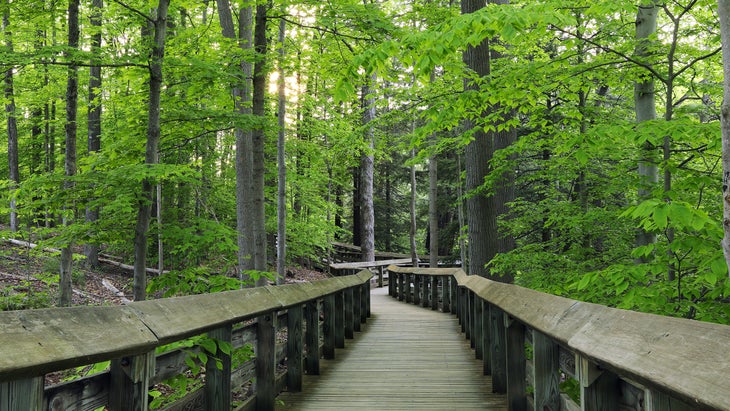
It’s a park for the people. CVNP is not your average national park—and its setup makes that clear. Instead of one vast, unspoiled stretch of wilderness, it’s a patchwork of protected land parcels. One moment you’re driving through the woods, the next you’re outside park bounds in a neighboring community. Why the confusing road map? In addition to protected gorges, forests, and waterways, the unit has working farms and numerous homes within park limits, including the quaint gateway town, Peninsula.
It’s accessible and easy-to-navigate. Lost? Don’t sweat it. Cell service is plentiful. Additionally, nearly all trailheads have a bathroom (and if they don’t, there’s inevitably one just down the road). Picnic areas and shelters also abound throughout, as do accessible visitor options, from wheelchair-friendly trails and fishing piers to guides and exhibits offered in braille.
A visit means fresh produce. Yet another reason CVNP isn’t your average national park: People don’t just visit here, or live here—they farm on this land, too. Agriculture is in Ohio’s DNA, and the park’s Countryside Initiative, launched in 1999, preserves the valley’s pastoral landscape and farming culture. Today, the 10 operating farms integrate sustainable growing practices and sell fresh fare via year-round in-park markets.
How to Get There
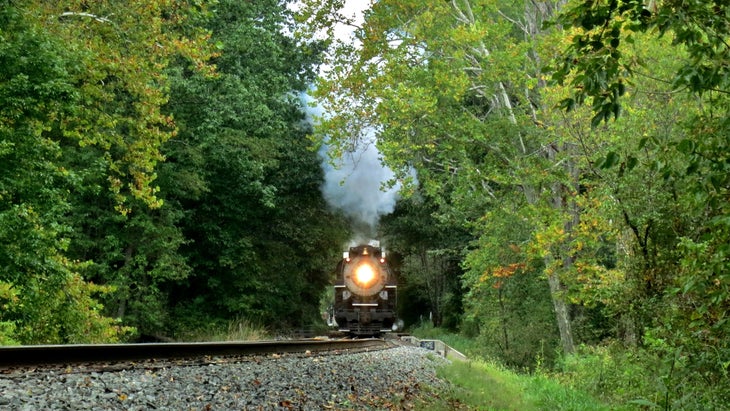
With Interstates 77, 70, and 271 running near and through the park, driving is the best way to reach and explore it. Along with being 30 minutes by car from downtown Cleveland, it’s also just a 15-minute trip from Akron, Ohio’s fifth-largest city, located just south of CVNP.
For air travel, head to Cleveland Hopkins International Airport. From there, head down I-71 and across I-80 to reach the park’s gateway town, Peninsula. Take Riverview Road north of Peninsula to reach the Boston Mill Visitor Center.
The Best Time of Year to Visit
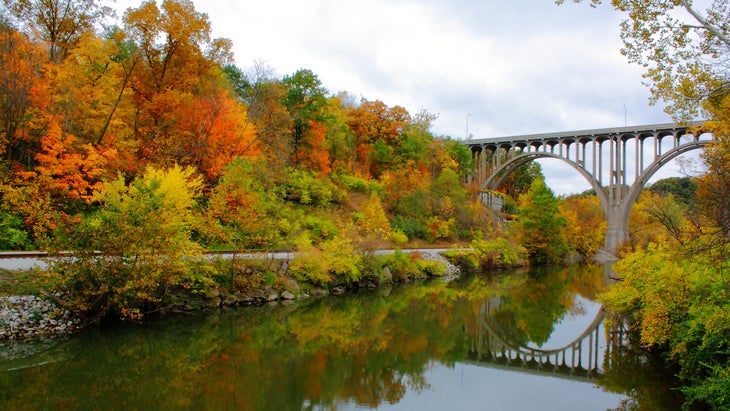
Given that Cleveland’s a four-season city, choosing when to visit Cuyahoga Valley depends on the adventure you’re after. Here’s what to expect throughout the year.
Spring
Spring can be a beautiful time to visit, with plenty of wildflowers, rushing waterfalls, and crisp temperatures in the 40s and 50s. It often snows into April, so for an easier excursion, plan for a late May trip, and pack layers just in case. When the weather does cooperate, try the Brandywine Gorge Trail or Haskell Trail to see the most vibrant wildflower displays.
Summer
Summer brings the biggest crowds—and for good reason. Farmers markets reopen. Live music at outdoor amphitheater Blossom Music Center resumes. And temperatures in the 80s and 90s attract hikers who’d been hibernating from Cleveland’s late-spring chills. In July and August, it’s best to visit around sunrise or sunset to avoid the heat and humidity, though dense hardwood forests of oaks, pines, and maples provide ample shade for midday excursions.
Fall
Bookmark October for peak leaf peeping, and head to fall-foliage vantage points like Ledges Overlook, the Brandywine Gorge Trail, and the Cuyahoga Valley Scenic Railroad’s fall-flyer trip to see what the autumn frenzy is all about. Temperatures hover between 60 to 70 by day, and can plummet to 30 or below at night.
Winter
Winter in this part of the state is not for the faint of heart. Lake-effect snow from neighboring Lake Erie brings unpredictable weather, not to mention around 61 inches of annual snowfall with temperatures from the 30s down to the teens. If you’re looking for fresh powder in the Midwest, the park has plenty of cross-country skiing and snowshoeing options, with rentals available at Boston Mill Visitor Center. CVNP also has its own Brandywine and Boston Mills Ski Resort (day passes from $50), a low-key hill where even the black-diamond runs are a breeze for intermediate skiers.
Where to Stay in or Near Cuyahoga Valley National Park
Camping
As of 2022, camping is not allowed within CVNP due to administration issues, according to local officials. For nearby camping, head up to the deep green forests of Brecksville Reservation, another wilderness escape just across the park’s northern boundary. Here, reservations ($5) unlock access to three backcountry sites. Try another unique Cleveland-area camping experience at Lake Metroparks’ primitive campgrounds, an hour southwest from the park. These secluded tent campsites sit atop the Lake Erie bluffs, offering gorgeous sunset views.
Within the Park
For lodging within the park, book the centuries-old Stanford House (from $400). This nine-bedroom rental, the former home of farmers, is steps from the famed Towpath Trail, a 87-mile bike path that bisects CVNP and follows the historic Ohio & Erie Canalway, which linked the northeast part of the state to the east coast. Then there’s the Inn at Brandywine Falls (from $175). Erected in 1848, this six-room bed-and-breakfast adjacent to a waterfall has quick trail access right from the property grounds.
Beyond the Park
For more options, overnight in Cleveland. Try Aloft Cleveland Downtown (from $135) in the city’s hip Flats district, situated along the Cuyahoga River’s crooked northwest terminus. The Flats, once dense with factories and smog in the mid-1900s, looks nothing like its polluted past. Trendy hangouts like BrewDog and Collision Bend Brewing Company, plus hotels, and recreation outfitters, have replaced those industrial-era eyesores.
What to Do in Cuyahoga Valley
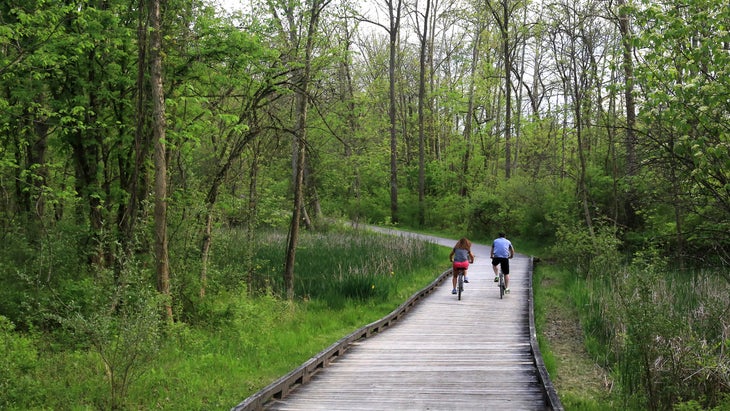
Hiking
A web of more than 125 miles of trails means there’s no shortage of excursions to suit every timeframe and skill level. For an afternoon hike, hit the two-mile Pine Grove Trail. This kid-friendly route shows off the park’s diverse flora, with wildflowers at ground level and lush green hemlocks and oaks above.
Nearly 40 miles of the state-wide Buckeye Trail pass through the park, with waterfalls and dramatic ledges as the backdrop. Most hike the 1,444-mile loop in sections versus a full-on thru-hike. One of the most scenic shorter stretches is this eight-mile route up and down some of the park’s hilliest terrain. It travels through dense forests, waterfalls, and creeks, before joining the Towpath Trail for an easy return.
To feel dwarfed beneath towering sandstone cliffs, hit the Ledges Trail, the park’s most hyped. This two-mile path features offshoot caves and boat-sized boulders, with the kind of jaw-dropping scenery many out-of-towners don’t envision when they picture Ohio. No trip is complete without admiring the thunderous Brandywine Falls, where water rushes down 60 feet into a namesake creek. Snag the best vantage point via the lower deck of the boardwalk or take the 1.5-mile Brandywine Gorge Loop to see this bridal-veil waterfall from multiple angles.
Dog adventurers, you’re in luck: Pets are allowed on 110 of CVNP’s 125 miles of hiking trails, making it one of the country’s most dog-friendly national parks.
Cycling and Mountain Biking
Roughly 20 miles of northeast Ohio’s multipurpose Towpath Trail ribbon through the park. The full 87-mile route starts in downtown Cleveland and winds south through CVNP, past Akron, and on to New Philadelphia. You can bring your own bike, or rent them through Century Cycles in Peninsula.
If mountain biking is more your speed, hit up the park’s MTB route: the East Rim Trail system, which connects with the Towpath Trail just south of the Boston Mill Visitor Center. This ride features two main loops and two side trails that total just over seven miles. Those who really want to get their fill can head to the Bedford Reservation, eight miles northeast, with nearly 10 miles of loops. Or, drive 30 minutes north of CVNP to Ray’s Indoor Bike Park, a 165,000-square-foot MTB playground. It’s open during the off season, form October through April.
Paddling
In 2020, the Cuyahoga River got a serious facelift: the removal of two dams let the river flow freely between the park and Cleveland for the first time in nearly 200 years. The full water trail spans 21 miles, and requires a full day of paddling. But kayakers can also enjoy shorter outings with the park’s Cuyahoga Valley Scenic Railroad’s (CVSR) kayak-aboard service (starting at $10), available on the Explorer train from June through October. For a 16-mile paddle trip, park at Lock 39 then take the train south to Lock 29. A roughly five-hour forested journey will lead you back upstream to your car. Take a shorter 10-mile version of this trip from Lock 29 north by parking and catching the train at the Station Road stop in Brecksville. Note, you won’t find rentals within CVNP, but you can book kayaks via Cuyahoga Valley Adventures, which also offers guided trips just south of the park in Akron.
Train Rides
The Cuyahoga Valley Scenic Railroad (CVSR) provides more than kayak and bike-aboard train trips. This rail line, which carried coal and passengers for more than a century, now offers a host of sightseeing and entertainment rides, complete with a free audio tour via the CVSR app. The roundtrip trip lasts three hours, and follows the length of the park from the town of Independence to Akron, with a handful of stations along the way. In addition to its regular year-round operations, themed rides offer a unique train experience you won’t find in other national parks, including a murder-mystery experience, cocktail-tasting excursion, and the annual holiday celebration, North Pole Adventure.
Wildlife Viewing
See rewilding in action at one of CVNP’s conservation vantage points: the Beaver Marsh, a peaceful wetland with a boardwalk. Before it became a park, this stretch was home to an old auto repair shop that dumped cars in the unused wetland. In 1984, Sierra Club volunteers launched a massive cleanup effort to save it. Beavers, who’d been gone from this area for a century after being over hunted for their fur, didn’t just return to this marshy area—they revived it. The beavers built dams that ended up flooding roughly 70 acres, recreating the wetland ecosystem it once was, and now home to animals like turtles, heron, and beavers. This boardwalk also links to the Towpath Trail.
The Best Places to Eat and Drink Around the Park
We’ll see your soaring snow-capped mountains and raise you a winery on national-park land. What CVNP lacks in those quintessentially dramatic landscapes, it makes up for with one-of-a-kind quirks—starting with Sarah’s Vineyard, which grows nine varieties of grapes and serves up delicious wood-fired pizzas and live outdoor music. For some grub outside of the park, try Pierogies of Cleveland, just west in the town of Richfield. The quick-service Polish diner offers a whopping 30 creative flavors, like yam and walnut, buffalo chicken, and goat cheese and mushroom. Grab a post-hike brew at the Winking Lizard in Peninsula, where you’ll find hundreds of local, regional, and national beer choices.
If You Have Time for a Detour
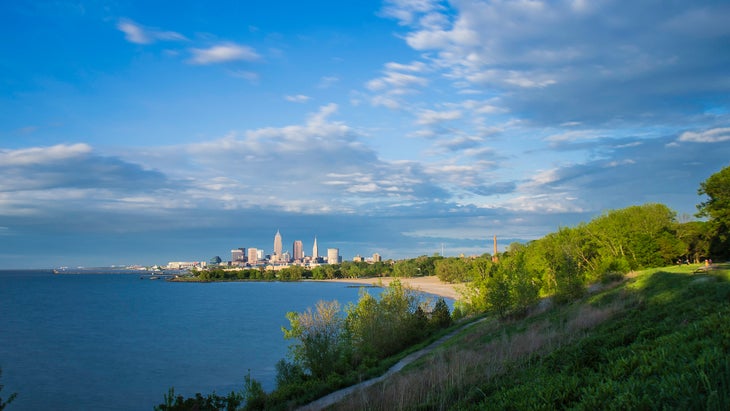
CVNP is a doable day trip, so you can and should spend the rest of your visit embracing another northeast Ohio gem: Lake Erie. This enormous body of water, the sixth largest in North America, has a surface area of roughly 9,990 miles. At first glance, it looks like an ocean—and on its best days, it acts like one, too. Strong winds and the right swells can bring waves of up to 10 feet to its shores, and those conditions have created an unexpected subculture of Great Lakes surfers. This growing community spans all five lakes, from the winter warriors up in Marquette, Michigan, to the Chicagoans who hit Lake Michigan.
In Cleveland, it’s tough to beat downtown’s surf hub, Edgewater Park. Non-surfers can hit the lake for paddling, angling, and even scuba diving. The park spans 147 acres, with 9,000 feet of shoreline, including a swimming beach and dog beach. It kicks off the city’s 17-mile Lakefront Bikeway, which links up with the Flats, downtown Cleveland, and beyond. If you have your pup in tow, this detour-to-your-detour is for them. Stroll from Edgewater up to the budding Battery Park neighborhood, where Terrestrial Brewing Company treats dogs as well as its drinkers: count the adjacent dog park and Sunday “Doggie Brunch” special as proof.
How to Be a Conscientious Visitor
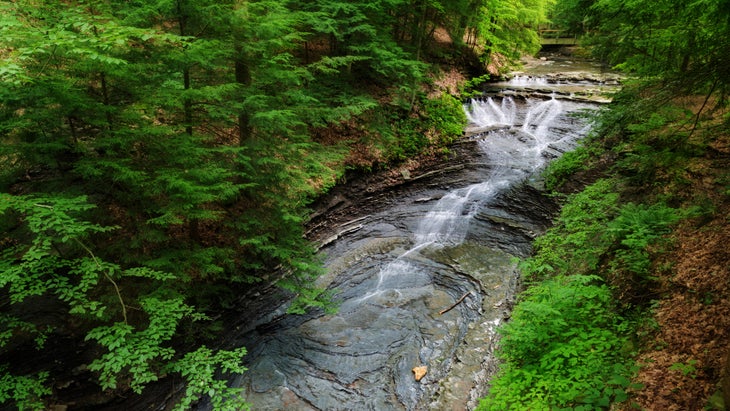
There’s no need to leave a trace in CVNP; virtually every trailhead and parking lot has a trash can and restroom onsite. Even so, the Conservancy for CVNP nonprofit recommends that visitors stay on designated hiking trails and keep a distance from wildlife; visit the Boston Mill Visitor Center for maps and a 3D tabletop model to familiarize yourself with the park’s geography.
Scott suggests another way to leave the area better than you found it: “I think every visitor should go and spend some dollars in Peninsula,” he says. The gateway village of Peninsula is the heart of CVNP; grabbing a drink or enjoying a bite in Peninsula isn’t just good for you—it’s good for the community. How’s that for incentive to indulge?




More Stories
Complete Guide To Exuma’s Hidden Gem
Birkenstock Sandals Are on Major Sale
Complete Guide To Austria’s Beautiful Capital City